1. Chain of Command
- Named decision-makers for each type of incident
- Escalation paths tied to severity and impact
2. Regulatory Response Protocols
- Predefined timelines for notifying regulators (e.g.. NCA, NESA)
- Templates for breach reports, disclosure statements, and legal reviews
3. Internal & External Communication
- Messaging templates for customers, partners, and media
- Social media handling guidance and media response plans
4. Cross-Functional Coordination
- Roles for Legal, PR, Compliance, HR, and Executive Management
- Governance alignment with DR/BCP and data loss protocols
5. Testing & Simulation
- Tabletop exercises for executive and operational teams
- Playbook integration into regular audit and readiness reviews
In this sense, the cyber crisis playbook is a governance instrument that helps organisations contain threats and control consequences. This structured approach enables CISOs to respond with clarity, rather than guesswork, when the stakes are highest.



